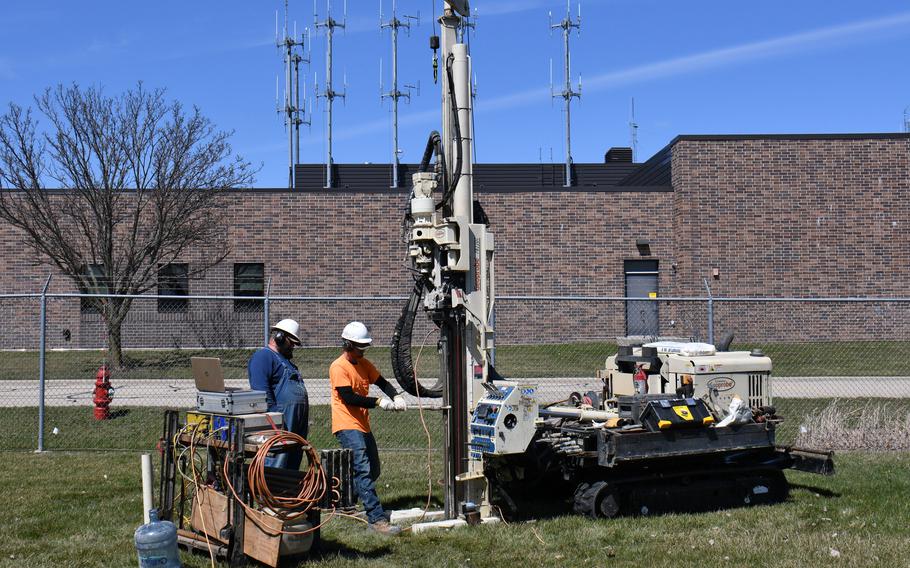
Workers with an environmental firm conduct testing for the presence of PFAS at Truax Field Air National Guard Base near Madison, Wis., March 22, 2022. (Paul Gorman/U.S. Air National Guard)
(Tribune News Service) — Dane County, Wis., says an experimental technology involving bacteria has been used to clean up toxic forever chemicals at the Madison airport, though county officials have not released any evidence.
The county and Wisconsin Department of Military Affairs issued a news release Tuesday claiming a nine-month pilot remediation project removed 97% of two fluorinated compounds from groundwater.
The chemicals, PFOA and PFOS, are found in firefighting foam used at military bases and airports and have been linked to cancer and other health problems.
County officials did not provide data to support the claim or say whether the treated water meets state or federal guidelines. Dane County Regional Airport spokesperson Michael Riechers said data would be released after it is presented to the state Department of Natural Resources, but did not say when that would happen.
But airport director Kimberly Jones said the pilot will be expanded to other parts of the airport, including one of two former training areas, known as "burn pits," that the DNR identified in 2018 as potential contaminated sites.
DNR officials did not respond to questions about the results or whether the county has been authorized to expand the project.
The project's cost is also unclear.
According to the county, the test cleanup was done by Orin Technologies, of Verona, and a Canadian company known as Fixed Earth Innovations, which have formed a new joint venture called Onur Solutions.
The process, according to materials on Orin's website, entails injecting a mix of chemicals and bacteria into the soil along with electrodes that generate oxygen. The idea is to trap PFAS so the microbes can break them down.
After 10 weeks at an unnamed "Midwest" airport, the company said, the total PFAS concentration in groundwater below a 1,600-square-foot area had been reduced by more than 96%.
But the company did not specify concentrations of individual chemicals, and the resulting PFAS concentrations were still thousands of times higher than what the U.S. Environmental Protection Agency says is safe for drinking water.
Studies urged
Treating the final 4% becomes exponentially harder, said Christy Remucal, an associate professor of civil and environmental engineering at UW-Madison.
Remucal said treating groundwater in place is typically more effective and requires far less energy than pumping it out and through filters, which then must be buried in special landfills.
But Remucal said there's little scientific evidence that biodegradation works on PFAS, whose strong molecular bonds make them difficult to break down and which tend to transform into other harmful substances.
Remucal wants to see controlled lab studies before the technology is tested in the field.
"You kind of need to see the data to see if that's really happening," Remucal said. "Microbes don't like to eat them. They're not a good food source."
To date, most PFAS remediation involves the use of filters to trap the chemicals.
Destruction is another matter.
New 'frontier'
"This is really where the frontier is," said Brittany Trang, a science writer who discovered a new method for destroying PFAS using solvents at relatively low temperatures as part of her Ph.D. research at Northwestern University.
Trang said the only method used at the municipal level is incineration, though if the temperature is not hot enough, that can result in formation of other fluorinated compounds or just spread the PFAS into the air.
"All the other ones are pilot-scale or lab-scale investigations," Trang said. "The method we developed is not ready for prime time in any sense."
Trang said a reputable study would account for what substances went in and what was recovered.
"Show that it didn't become something else that we have to worry about," she said.
It's been more than four years since the DNR notified the county, along with the city of Madison and the Wisconsin National Guard, that they were responsible for PFAS contamination at the airport, where tests of groundwater and stormwater confirmed concentrations of two compounds thousands of times higher than state standards and millions of times what the EPA considers safe for consumption.
The airport drains into Starkweather Creek, which flows into Lake Monona, where health officials have warned anglers to limit consumption of fish because of the chemicals, which have been linked to illnesses including high blood pressure, low birth weight, developmental delays and cancer.
The city and county have deferred to the National Guard Bureau, which is investigating contamination at Truax Field under a federal process that could take a decade for actual cleanup work to begin.
This summer, after learning that the Pentagon did not include the burn pits in its remediation plan, the DNR again ordered the city, county and guard to submit a cleanup plan for the burn pits.
Jones responded earlier this month saying the county and its partners are working to come up with a plan to do more testing of the burn pits and alluded to promising results from the pilot program, which the DNR previously said was not successful at reducing PFAS in stormwater.
"We trust that the additional time it is taking to gather that data is a worthwhile investment to assure all concerned that the remediation technology will succeed," Jones wrote. "We also trust that the Department recognizes that past efforts once characterized as failed are in fact part of the robust scientific process that have led to these hopeful developments."
(c)2022 The Wisconsin State Journal (Madison, Wis.)
Visit at www.wisconsinstatejournal.com
Distributed by Tribune Content Agency, LLC.